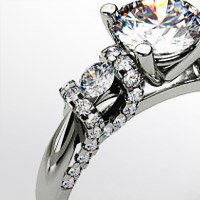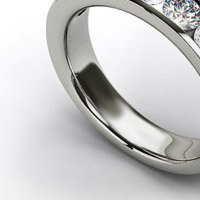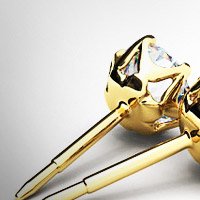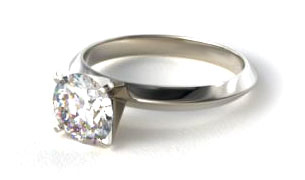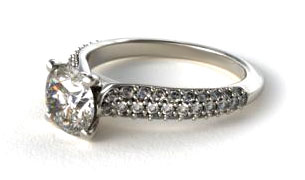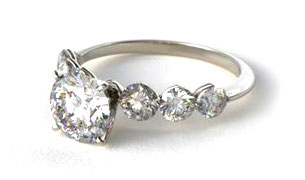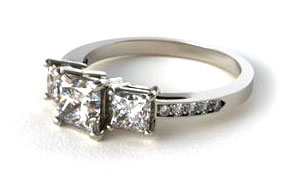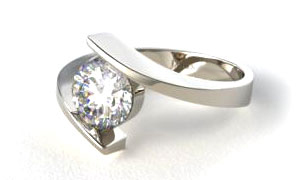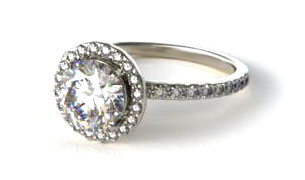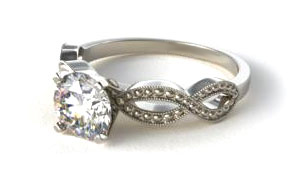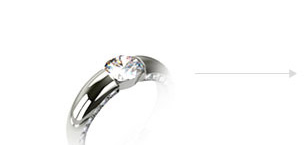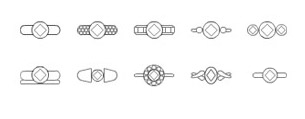
Ring Types
One of the most important steps in buying an engagement ring is determining your ring type. skc jewelry offers a variety of engagement ring styles from classic solitaires to modern tension rings. Whether you are looking for a modest, traditional ring or something flashier, skc jewelry has a ring type just for you.
Solitaire Engagement Rings
A solitaire ring setting features a single stone, typically a diamond with a plain mounting (usually four or six prongs). Solitaires are one of the most popular engagement ring settings. Their appeal is in their elegance, simplicity, and timelessness. Solitaire engagement rings come in a variety of sizes and styles. Some have narrower bands which have the effect of making a smaller diamond appear larger, and compliment small fingers. Others have thicker bands which allow for more options in the way the diamond is set. Many solitaire rings have ring guards (or rings wraps) which frame the center diamond, making it appear more prominent.
Pavé Engagement Rings
A pavé engagement ring is encrusted with very small diamonds all along the band to give the appearance of a solid diamond surface. Because pave-set diamonds use only tiny beads or prongs to hold them in place, very little of the metal band shows through and the diamonds appear to be free-standing. Pave settings can either go around the whole band (full pave) or stop halfway around it (half pave). Micro pave rings are even more delicate and intricate than regular pave settings. The individual stones are so small that they appear to blend together and create extraordinary fire. Typically, round brilliant or princess cut diamonds are used as center stones in pave engagement rings. Most center stones are prong-set, basket-set or bezel-set.
Channel Set Engagement Rings
Channel set engagement rings feature side diamonds that are embedded into the channel groove of the ring. A thin strip of metal secures the diamonds in place—no prongs are used. The diamonds are flush with the band and as a result, channel set rings are sturdier than other designs and less likely to snag on clothing. Channel settings are available in gold and platinum, with a variety of diamond shapes and cuts. When it comes to picking the right channel stones for your channel ring, princess cut is a popular choice, as its square edges ensure no gaps between the stones.
Sidestone Engagement Rings
Sidestone engagement ring settings provide a perfect complement to a center stone and typically consist of a center diamond flanked by two or more smaller-sized side diamonds. Because sidestones add size and brilliance to the center diamond, they make the overall appearance of the engagement ring more impressive and radiant. When it comes to selecting a center diamond for an engagement ring with side stones, round brilliant or princess cut diamonds are typically chosen, although most diamond shapes can be used.
Three-Stone Engagement Rings
Three stone engagement rings consist of a center diamond flanked by two side diamonds, which accentuate the size and brilliance of the center diamond.The center stone is usually set higher to complement the side stones and add depth to the ring. Round or princess cut diamonds are the most popular choices for center stones. Most center stones are prong-set, basket-set or bezel-set, as these settings effectively distinguish the center diamond from the setting.
Tension Set Engagement Rings
Tension engagement rings are a modern engagement ring setting in which a diamond is held in place by the physical force of the setting, without any prongs. In a tension ring, the diamond appears to be floating in air. As the name suggests, tension rings use the force and tension of the ring to push against the diamond to hold it in place. Tension cut engagement rings are some of the most secure engagement rings around as the whole ring works to hold the diamond in place even tighter than prong settings. Since tension cut engagements rings show off the entire diamond, the shape and cut of the diamond is extremely important. Round, princess, and emerald-cut diamonds are popular choices for tension set rings.
Halo Engagement Rings
Halo engagement ring settings feature a center gemstone surrounded by smaller, micro pave diamonds. The smaller diamonds give the appearance of size and volume to the center stone, adding to the ring’s overall sparkle. Traditional halo engagement rings are a more modern take on the classic solitaire ring, while vintage-style halo rings focus on the micro pave and milgrain detailing along the band. Halo engagement rings come in all shapes and sizes of center stones. Some feature round stones, asscher-cut diamonds, pear-shaped and oval diamonds. Halo rings often feature colored gemstones, like blue sapphires or red rubies.
Vintage Engagement Rings
Vintage and antique-style engagement rings offer the beauty and intricate craftsmanship of vintage rings with the sturdy and lasting design techniques of modern engagement rings. Vintage-style engagement ring designs often draw inspiration from various time periods and contain diamonds with modern diamond cuts, which maximize fire, brilliance, and light reflective properties. skc jewelry offers a variety of vintage and antique-style engagement rings in yellow gold, white-gold and platinum. Most diamond cuts are used as center stones for vintage rings. In vintage rings, center stones are usually prong-set, basket-set or bezel-set.
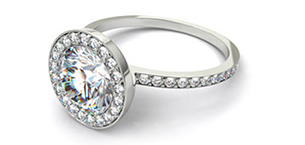
Setting Types
An engagement ring should be a reflection of the person wearing it.
Here are a few tips to help begin:
A woman with simpler, more streamlined taste may prefer
a
beautifully-made solitaire setting with one fantastic
diamond.
For women who like a lot of sparkle, an intricate pave
setting
with rows of diamonds might be preferable. A vintage
setting
with delicate engraving might appeal to a woman who has
a
penchant for the classics. Beautiful baguette side
stones give a
more contemporary feel to a ring, and gemstone settings
are
great for a woman who loves color. Tension settings will
likely
appeal to a more modern woman. Consider the woman, and
the right
style will become clear. Remember that the wedding band
that
will follow will need to match the engagement ring in
terms of
style and metal. The width of the ring is also a factor,
since
it will soon have a wedding ring next to it. A woman
with small
hands will want a narrower band on her rings, while a
woman with
larger hands might prefer a wider band.

Prongs
Prongs are the
most
traditional setting technique. Prongs allow for maximum
exposure of
the diamond and minimize the presence of metal (gold or
platinum).
In turn, more light is able to pass through the diamond,
which only
adds to its brilliance.

Bezel
This setting
style,
primarily known for its simplicity and durability, encases
the
surrounding outer edge of the diamond in a fine frame of
metal (gold
or platinum). When using white gold or platinum it can often
give
the diamond a larger appearance. The bezel setting is a
versatile
one because it can accommodate every diamond shape.
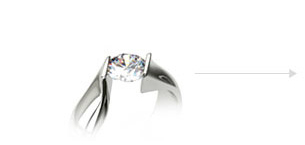
Tension
A tension
setting is a
modern and beautiful method of setting a diamond into a
ring. In
tension-set rings, the diamond is essentially "squeezed"
into a
small groove that is cut into the tension mounting. The
mountings
are manufactured using precious metals that are especially
hardened
to grip the diamond without the necessity of prongs. The
settings
are designed to be very secure.

Channel
Channel
settings are a
loved for their brilliance and durability. With this
setting, small
diamonds (usually round or princess-cut) are set deep into
the metal
band, thus creating a “channel” which holds the diamonds.
The small
diamonds are very secure because they are embedded into the
metal,
making it very difficult for them to fall out. For this
reason,
channel settings are a particularly good choice for people
who work
with their hands.
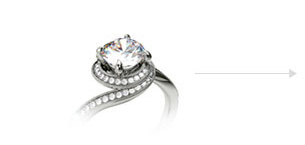
Twist
Twist settings
are
becoming more and more popular among couples looking to buy
an
engagement ring. In this setting, the metal band is shaped
and
turned to create a crisscrossed effect. The result is a
unique look
that is as complex as it is delicate.

Ring Sizing
Your engagement ring or wedding band should fit comfortably — not too tight, but not too loose either. The perfect ring fits loose enough to slide over your knuckle and tight enough so that it cannot fall off your finger. To find your ring size, you can use skc jewelry’s online ring sizer or request a free plastic ring sizer. Keep reading for tips on how to measure your finger size and make sure that you purchase a ring that fits just right.
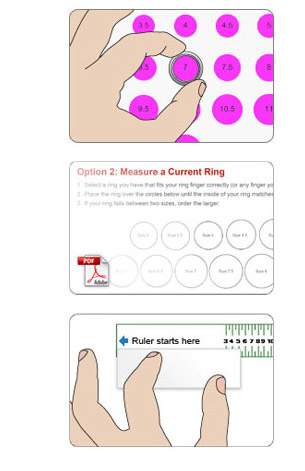
Online Ring Sizing:
Sizing an engagement ring is easier than you think. skc jewelry offers a free online ring sizer to help you determine your ring size. The online ring sizer is easy to use and offers two options; you can find your ring size by using the ring sizer to measure your finger or you can measure a ring that you already have. Both are accurate and will give you your exact ring size. If for some reason, the ring you order does not fit comfortably, don't worry! skc jewelry will resize your ring once for free within the first year of your purchase, including free return shipping within the U.S. and Canada for the first resize.
*Some rings cannot be resized and will need to be remanufactured. There will be a fee for rings that need to be remanufactured outside the 30-day return policy.
Tips for Finding Your Ring Size:
- Measure your finger at the end of the day.
Your finger size changes depending on the weather and time of day. For best results, measure your finger size at the end of the day when your fingers are warm. (Early in the morning, your fingers are cold and therefore smaller.)
- Measure a few times.
Be sure to measure your finger size a few times to make sure your calculations are accurate.
Tips for Buying a Ring as a Surprise:
- If you don't know your girlfriend's (or boyfriend's) ring size, ask her/his close friends or family members. Tell them to keep it hush-hush so that they don't accidentialy ruin the surprise!
- Borrow his/her ring (from the correct finger!) and use skc jewelry's online or plastic ring sizer to determine the ring's size.
Remember, you can have a skc jewelry resize your ring once for free within the first year of your purchase, including free return shipping within the U.S. and Canada for the first resize. For more information regarding ring sizing, feel free to contact customer service, available 24/7.
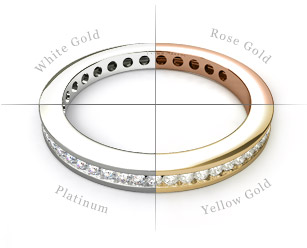
Metals
Choosing the right metal for an engagement ring is a crucial part of the ring-design process. Once you know a bit about the basics of ring metals, deciding on a metal is a rewarding and simple process. Choosing between white gold, yellow gold, or platinum is as much as matter of personal preference as it is of budget. Before you make a final decision, it is worth weighing the pros and cons of the various types of engagement ring metals.
White Gold Engagement Rings
White gold is an incredibly beautiful and popular choice for engagement ring settings, which is quickly becoming the number one choice in engagement ring metals. skc jewelry offers white gold in 14K and 18K. 14K gold contains 58.5% gold, while 18K white gold is made up of 75% gold and 25% other metals (nickel, zinc, etc). White gold has the overall look of platinum, but is notably less expensive. White gold beautifully compliments diamonds that are rated D-I on the diamond color scale, as it enhances the brilliance and sparkle of the stone.
White gold is typically alloyed with nickel, zinc, silver, and/or palladium to give it its white color and is often plated with rhodium—a shiny, white metal that is a member of the platinum family—to give it an even whiter appearance and protect it from color loss. Although white gold is not subject to tarnish, it may develop a slightly yellow color over time as a result of its 75% yellow gold content. If this happens, white gold’s original beauty can be restored by a simple re-plating.
Even though white gold is resilient, there are important measures you can take to keep you jewelry looking as good as new. To keep white gold shiny and scratch-free, store it in a soft cloth bag or fabric-lined jewelry box. White gold should be cleaned with mild soap and warm water, using a non-metallic, soft brush (like a toothbrush). To retain white gold’s luster, make sure to keep it away from harmful and corrosive chemicals such as bleach, ammonia and chlorine. And always use a soft, lint-free cloth—never paper towels—to dry the jewelry.
Yellow Gold Engagement Rings
Yellow gold is the most common of the golds, partly because gold is yellow in its naturally occurring state. The yellow gold used in fine jewelry is typically alloyed with silver and copper; its color depends on the amount of pure gold in the alloy. The advantages of gold are that is does not corrode, tarnish or rust, so it can be counted on to provide lasting beauty. And even though it is strong, gold is more "flexible" than the other precious metals.
Pure gold, graded 24 karats, is too soft for use in making jewelry—as a rule, the higher the karat count, the softer the gold. 18kt gold is composed of 75% gold alloyed with 25% other metals, and is used in the making of fine jewelry. 14kt gold, which is composed of 58.3% gold, is commonly used in jewelry in which strength and hardness are important factors. 10kt gold is made up of 41.7% gold, and 10 karats is the minimum amount of karats an items needs to be classified as real gold in the U.S.
Authentic gold jewelry bears a "karat mark", which is a "k" stamp. According to U.S. law, every gold item must also be stamped with the manufacturer's trademark and country of origin to ensure the authenticity of the gold.
Even though gold is resilient, there are important measures you can take to keep you jewelry looking as good as new. To keep gold shiny and scratch-free, store it in a soft cloth bag or fabric-lined jewelry box. Gold should be cleaned with mild soap and warm water, using a non-metallic, soft brush (like a toothbrush). To retain gold’s luster, make sure to keep it away from harmful and corrosive chemicals such as bleach, ammonia and chlorine. And always use a soft, lint-free cloth—never paper towels—to dry the jewelry.
Platinum Engagement Rings
Platinum is a rare and valuable metal that is only found in limited quantities in a few, select regions of the world. The annual worldwide production of platinum is approximately 160 tons, compared to 1,500 tons of gold. This is why platinum is more expensive than the other precious metals.
Platinum has grown increasingly popular in recent years due to its beauty and durability. Platinum’s rich, even color and sheen makes it a popular choice for engagement ring settings, as these qualities magnify the sparkle and brilliance of diamonds that are set in the metal. An added bonus of platinum’s 90-95% purity grade is that it rarely causes any allergic reaction, and is therefore the ideal metal choice for people with metal or contact allergies.
Platinum is strong and can withstand a lot of stress, more so than other precious metals. It is also a naturally white metal that naturally retains its brilliant white luster naturally— white gold, on the other hand, which is mixed with alloys to give it its white appearance, loses its white shade and begins to yellow over time; white gold jewelry needs to be re-plated during its lifetime in order to maintain its white color, whereas platinum naturally retains its color. Most fine platinum jewelry uses 95% platinum, with 5% alloys. The closely-related iridium, palladium, and ruthenium are alloys that lend additional strength to platinum. In the United States, every piece of platinum jewelry sold must carry a purity stamp. "950 Plat" indicates 95% purity and "900 Plat" indicates 90% purity. In the U.S., anything less than 90% pure platinum cannot be sold as "platinum" jewelry.
Maintaining the appearance of platinum is as simple as soaking the jewelry in a mild solution of soap and warm water and gently scrubbing with a soft-bristled brush. To keep platinum shiny and scratch-free, store the jewelry in its original box, a soft cloth bag, or a fabric-lined jewelry box. If platinum is worn daily, it may develop a slight sheen. Although most people prefer this look, you can always have jeweler polish platinum jewelry restore it to its original shine.
Rose Gold Engagement Rings
Rose gold is a gold and copper alloy commonly used for specialized jewelry and coveted for its warm, reddish color. Rose gold is also known as red gold and pink gold, and sometimes as Russian gold, as a result of its popularity in Russia in the early 19th century. The difference between red, rose and pink gold is their copper content.
The higher the amount of copper in gold, the more pronounced the red color. Pure gold is a deep yellow color and pure copper is reddish. The color of rose gold is somewhere on the spectrum between the two, depending on its individual composition. A common alloy for Rose gold is composed of 75% gold and 25% copper by mass.
Even though gold is resilient, there are important measures you can take to keep you jewelry looking as good as new. To keep rose gold shiny and scratch-free, store it in a soft cloth bag or fabric-lined jewelry box. Rose gold should be cleaned with mild soap and warm water, using a non-metallic, soft brush (like a toothbrush). To retain rose gold’s luster, make sure to keep it away from harmful and corrosive chemicals such as bleach, ammonia and chlorine. And always use a soft, lint-free cloth—never paper towels—to dry the jewelry.
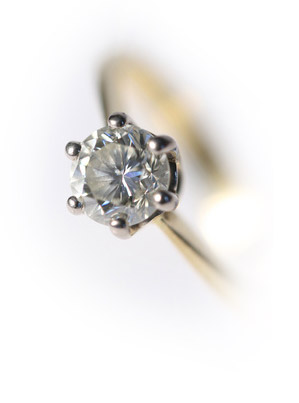
Buy an Engagement Ring on a Budget
Buying an engagement ring is an exciting process. With skc jewelry you can buy an engagement ring within your budget, from the comfort of your home or mobile device.
Here are some basic guidelines on how to buy an engagement ring on a budget:
-
A Diamond Certificate Doesn’t Tell You the Whole Story
If you base your diamond decision on a laboratory certificate alone, you can end up paying more. Although a certificate is useful for authenticating a diamond and providing basic specifications of a specific stone, a certificate alone doesn’t reflect the true beauty and value of a diamond. Two diamonds can be categorized as having the same characteristics on a diamond certificate, yet be priced differently, and the certificate won’t tell you why. A diamond certificate doesn’t indicate how a stone’s inclusions affect its beauty and value. You need to actually see a diamond to understand the nature of its inclusions.
At skc jewelry, you can view each diamond magnified with Diamond Display Technology. This technology shows you exactly what the actual diamond looks like, with all its inclusions and brilliance. Seeing actual diamond photos puts you in control of the purchase process and gives you the confidence of knowing that you’re getting the best diamond for your money.
-
A Diamond's Cut and Shape Come First
Cut refers to the diamond’s proportion and facets. Shape is the overall geometric form of the stone (e.g. round, square, oval). A diamond’s cut and shape affect many aspects of the stone’s overall appearance and price; cut can be graded, whereas shape cannot. Experts say cut is the most important buying criteria, because it determines the diamond’s sparkle and brilliance, and recommend buying the best possible cut that you can afford.
Diamond shape is a very personal choice and you should go with the shape you like best. If you decide on a shape and cut first, it will be easier to decide on the other C’s. Choosing a cut and shape you love will save you money in the long run, as you’ll be less inclined to change your ring or upgrade down the line.
-
Choose a Diamond With a Clarity and Color Grade that Looks "Clean" to the Naked Eye
When it comes to white (non-fancy) diamonds, most consumers can't tell the difference between diamonds on the very high end of the clarity scale ( like VVS1), and those lower on the scale which contain very slight or slight inclusions (VS1 or SI1). In the case of many SI1 diamonds, for example, the flaws are only visible under 10X magnification, although the price difference between a VVS1 and an SI1 diamond is considerable.
Keep in mind that some diamond cuts, such as the popular round cut, mask inclusions and flaws very well. So if you're on a budget, you don’t necessarily need to buy an internally flawless diamond. A lower-clarity stone that looks clear to the naked eye is probably sufficient.
The same advice applies to a diamond’s Color Grade. The Gemological Institute of America (GIA), the American Gem Society (AGS), and the International Gemological Institute (IGI) grade a diamond’s color on a scale of D (colorless, and most desirable) to Z (least desirable, with a visible yellow tint).
A "D" or "F" diamond (colorless) can easily cost double that of an “I” (near colorless) diamond of the same cut, although most people can’t tell the difference between the two. If you’re on a budget, use your eyes as a guide. You don't need to buy a diamond that's on the highest end of the color scale. With skc jewelry’s Diamond Display Technology, you can view a magnified version of the actual diamonds on our website in high-definition which shows you the true and exact characteristics of the stone, to help you make an informed buying decision.
-
Good Polish is Good Enough
A diamond's polish refers to the smoothness of the exterior surface of the stone. When it comes to diamond's polish, a "good" grade is good enough for most cases. Most consumers can't tell the difference between a diamond with "good" and the more-expensive "excellent" polish.
-
White Gold is a Great Alternative to Platinum
Although platinum is the preferred ring metal of choice, it is also the most expensive of the precious metals used in jewelry. White gold, on the other hand, is an excellent and affordable alternative to platinum and a great choice for the budget conscious shopper. White gold has a stunning appearance and a white/gray patina that resembles platinum. White gold is also very durable, has a high scratch resistance factor, and does an excellent job of drawing attention to a diamond’s brilliance.
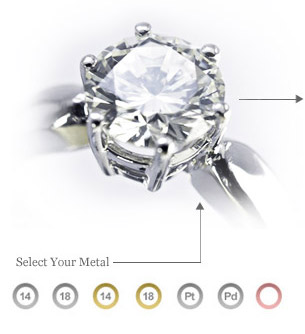
How to Choose the Perfect Engagement Ring
A diamond engagement ring represents love and commitment. It is an outward sign of the inward love you have for your bride-to-be. Before purchasing your diamond engagement ring, there are a few things to consider.
The 4Cs of Diamond Quality
Diamonds are priced according to the 4 C’s: cut, color, clarity, and carat weight. Please read our diamond education, as well as "How to Choose the Perfect Diamond," to learn about each attribute in detail and what diamond grade offers the best value for your budget.
In addition to the 4 C’s, shape (e.g. round, pear, marquise, oval, heart, etc.), brilliance, dispersion and scintillation determine a diamond's value.
Select Your Metal First
Engagement rings are typically made from one of three metals: platinum, white gold, or yellow gold. Platinum is the most expensive metal as it resists tarnishing, but it is also the most expensive to repair if damaged.
Yellow gold rings are the most popular and are available in 14-karat or 18-karat gold. Although this type of ring can show scratches and other abrasions, repairs come easy.
White gold rings have a silver-like appearance which will eventually wear off and need to be replaced. The appeal of white gold is that it easily matches most other jewelry.
Choose Your Setting Wisely
Engagement ring styles are individual and should match the personality of the person who will be wearing it. There are endless options of standard and custom engagement ring settings from simple solitaire settings to contemporary tension settings. Prong settings are among the most popular settings as they make the center diamond appear as though it is hanging, which creates an attractive sparkle. To learn more about setting options, check out our education center.
Once you have chosen the setting and diamond, your work is done. skc jewelry will then prepare your perfect engagement ring and have it ready for you to present to your beloved as you ask for her hand in marriage.
Certificate of Appraisal
Upon purchasing your diamond and setting, you will receive a certificate of authenticity. This certificate will confirm the engagement ring's value and is what you will need if you choose to insure your purchase. Most certificates are issued by the American Gem Society (A.G.S.) or the Gemological Institute of America (G.I.A.), two of the most widely accepted certifying organizations for the diamond industry. All of skc jewelry’s diamonds come with certificates of appraisal. Do not purchase a diamond if it does not come with a certificate from a reputable.
A Guarantee or Warranty
Depending on the jeweler, some type of guarantee or warranty may be offered with your purchase. Many jewelers provide a limited time money back guarantee while others will give to you a lifetime warranty. Understand what you are buying and the policy before you make your purchase.
If you have any questions or need any help selecting the perfect engagement ring, feel free to call our gemologists or customer service experts, available 24/7.
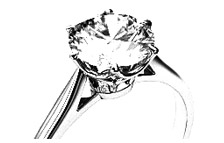
Ring Manufacturing
MODEL MAKING
Jewelry manufacturing begins with the model. There are 2 main ways to build a model.
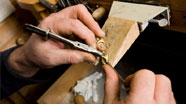
By Hand
Skilled craftsmen either
carve a
design out
of wax, or craft different elements of metal together to create
a
master
model.

By Computer (CAD)
Computer designers
utilize
special
programs to build images that create the tiniest details.
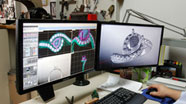
CAM
Computer designers utilize
special
programs to
build images that create the tiniest details.
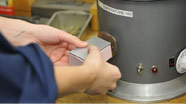
MOLD MAKING AND CASTING
Once you have a model, a mold is made. A mold enables you to duplicate the model as many times as you would like in any metal. Hot wax under pressure is injected into the mold and removed when cooled, which serves as a casting model.
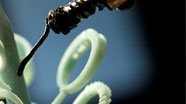
Waxes are grouped together on a wax tree with other styles to be casted in the same metal and color.
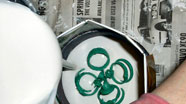
The wax tree goes into a form, where plaster is poured into it. The form is baked overnight and the wax is melted away. This leaves an empty cavity of the rings.

Metal is heated to extreme temperatures and transformed to liquid. The metal is vacuumed into the plaster form with the now empty cavity of rings.
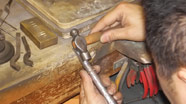
JEWELRY MAKING
When a ring style is ordered, different metal components are ordered to the specifications of the desired ring. Those components are pieced together and cut to size. We either solder or laser the metal to weld it to accommodate the proper center stone and finger size. Since platinum requires such high heat, it is always welded by laser.
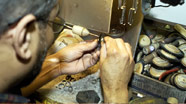
Next, the rings go through a series of polishing stages to prepare them for stone setting. Diamonds and gem stones are picked to the specifications of the style, accurate to the .01mm. Color, clarity, and cut of each accenting diamond or gem stone is double checked.
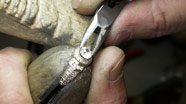
Using special drill heads in the actual shape of diamonds, bearings are cut in the metal. Each stone is set into its bearing and secured by the surrounding metal. There are several different methods to securing stones to jewelry.
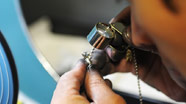
POLISHING AND FINISHING
Once the ring is assembled and stones are set, it's time to finish the piece.
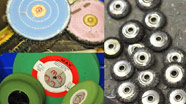
Using different sized and shaped buffs and polishing brushes, we are able to access every part of the jewelry - from inside to underneath the gallery.
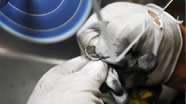
The final polishing step is called lapping. Lapping ensures the ring have a smooth, high quality finish.
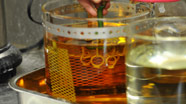
Since white gold is not pure white, it requires plating. We plate our jewelry by attaching electrodes, then dipping in rhodium solution. Rhodium is a pure white metal.

